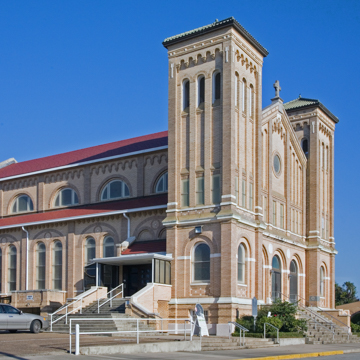Our Lady of Lourdes was originally the parish of Victoria's substantial German community. Its imposing church, as large as the other downtown parish, St. Mary Catholic Church ( VI7), was the work of San Antonio architect Dielmann, who designed numerous Catholic churches and institutions throughout Texas in the first half of the twentieth century. Set on a high raised basement, the church is notable for its scale and the subtle contrast of its two tones of brick, brown outlining a buff field.
Across from the north side of the church at 210 E. Forrest Avenue is the Theobald Sengele House (1844), the oldest surviving building in Victoria. It bears evidence of an extremely unsympathetic remodeling of 1952. Backing up to Our Lady of Lourdes is the imposing Palladian U.S. Post Office and Courthouse (1913) by James Knox Taylor, Supervising Architect of the U.S. Treasury, at 210 E. Constitution Avenue.















